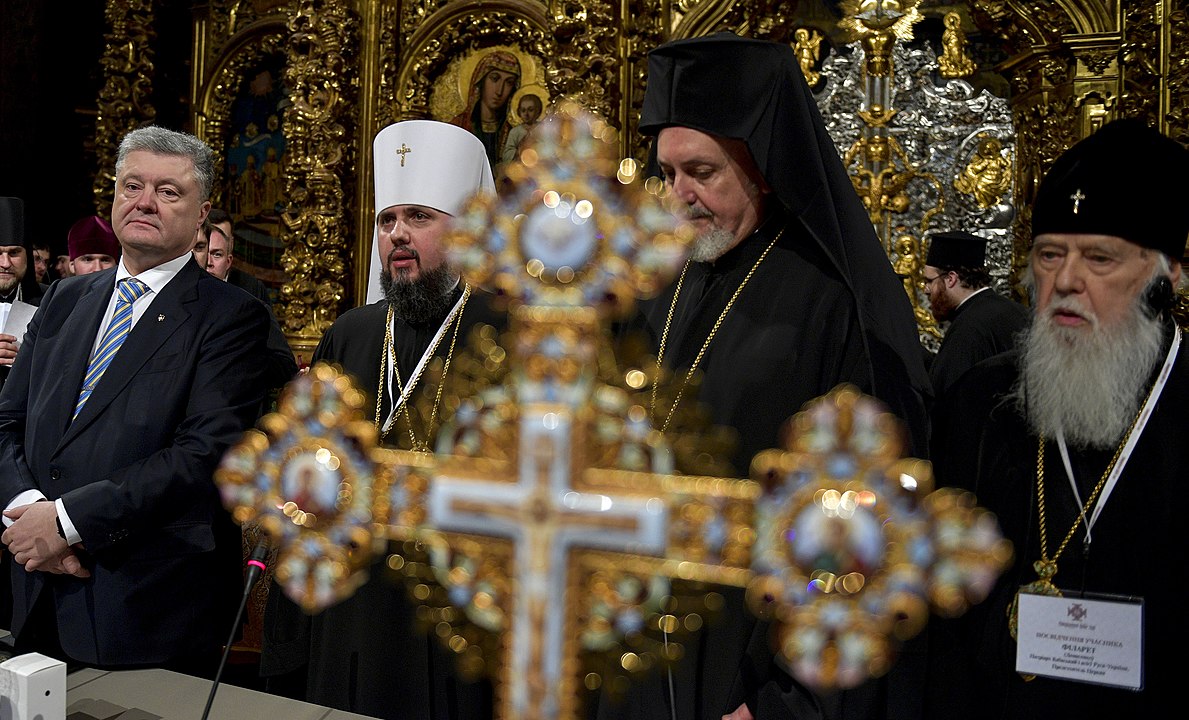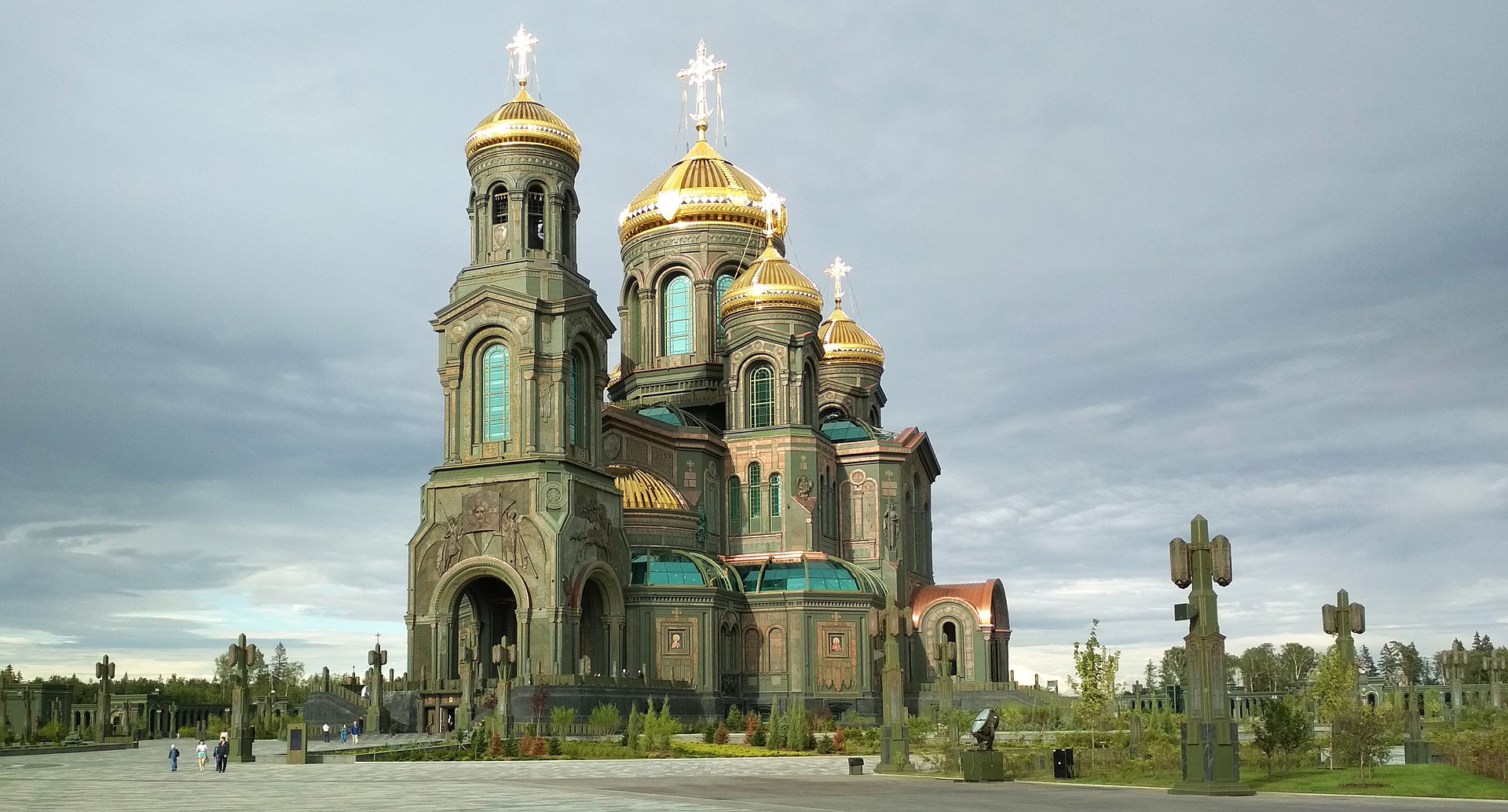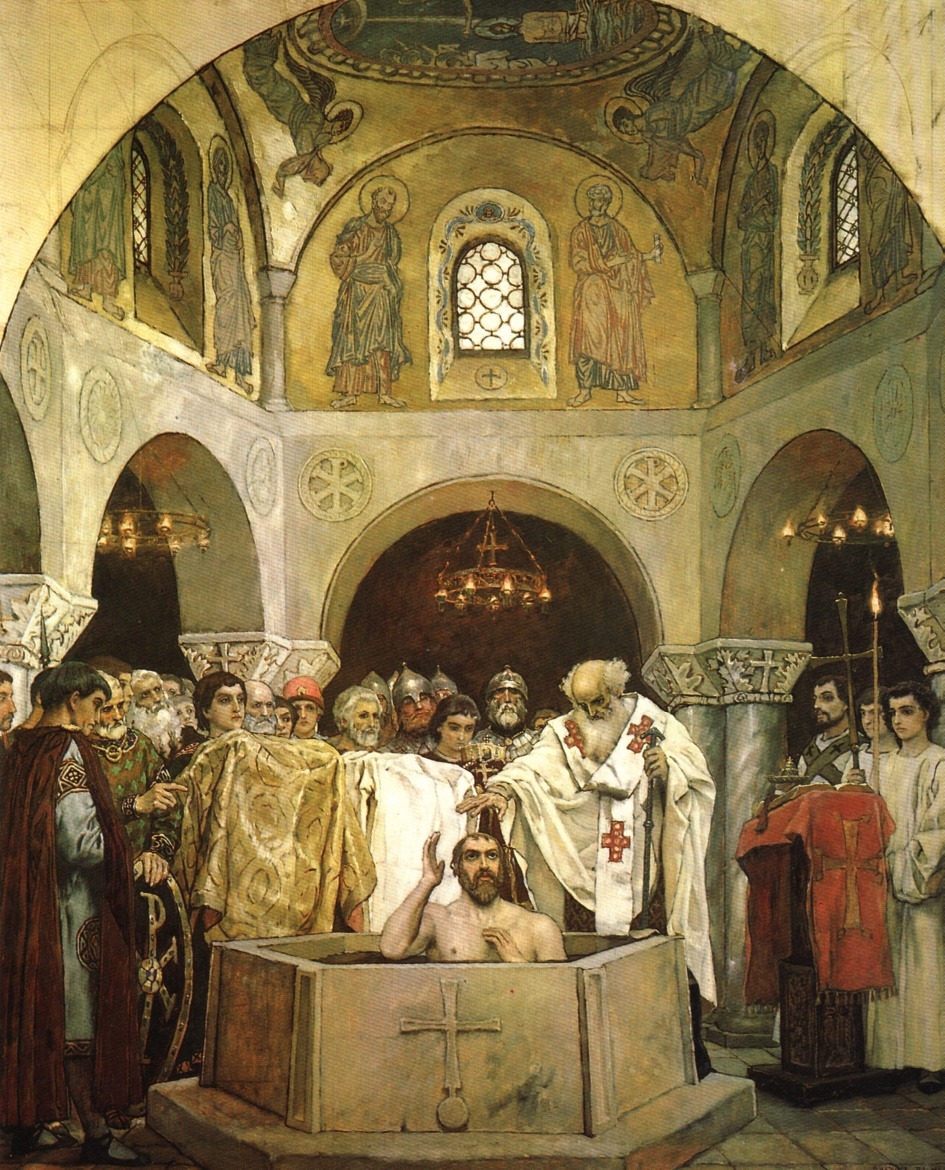The Religious Dimensions of the Ukraine War

By Harry Clynch
Staff Writer
31/5/2022

Left to right: Petro Poroshenko (former Ukrainian president), Epiphanius I (primate of the Ukrainian Orthodox Church), Metropolitan Emmanuel of France (a French bishop), and Filaret (primate of the Ukrainian Orthodox Church – Kyiv Patriarchate, which has since been folded into the Ukrainian Orthodox Church) at the 2018 council that voted to unite most Ukrainian Orthodox churches into an independent church (Picture Credit: The Presidential Administration of Ukraine.)
Around 40 miles south-west of Moscow lies the new Cathedral of the Russian Armed Forces. Opened in June 2020, the cathedral is a distinctly military khaki-green, with its floor made from melted-down Nazi tanks. The main dome is precisely 19.45 meters in diameter – a subtle reference to the end of the Great Patriotic War. Leaked photos during its construction show the authorities considered including a mosaic of President Vladimir Putin, but they settled for one depicting guardian angels looking over the Russian crusaders who recently fought in Georgia, Syria, and the Crimea.

The Cathedral of the Russian Armed Forces (Picture Credit: Sergey Sebelev)
As symbolism goes, it doesn’t get much more direct. The Cathedral of the Russian Armed Forces is a physical testament to the powerful interplay between the church, the military, and the state in modern Russia. As the war in Ukraine rages on, it’s clear that this symbiotic relationship has lent the conflict a markedly religious element. As with the sectarian battles of yesteryear, could this make the prospect of compromise or peace in Ukraine that much more difficult?
It’s important to appreciate just how far back Russia’s attachment to Ukraine goes – and the central role Ukraine has played in Russia’s religious life. The Russian Orthodox Church, which is based in Moscow, has long considered Kiev its spiritual capital. The city’s status as the center of Russian Orthodoxy can be traced all the way back to the 9th century. Prince Vladimir of Kiev (later canonized into a saint), wishing to marry the Christian daughter of the Byzantine Emperor for political advantage, dropped his fanatical paganism and embraced Christianity. Having been baptized in the Crimea, Vladimir returned triumphantly from his wedding and ordered mass baptisms for the residents of Kiev. Over the coming days, thousands came to be Christened in the city’s Dnieper River. With the influence quickly spreading eastwards, Russian Orthodoxy was born.

The Baptism of Saint Prince Vladimir by Viktor Mikhailovich Vasnetsov
For this reason, and the fact that Russians and Ukrainians were formally united on theological matters under the jurisdiction of the Russian Orthodox Church for over three centuries, the church has always seen Ukraine as part of a wider Russia. In the words of Patriarch Kirill of Moscow, the current primate of the Russian Orthodox Church, Kiev is “the mother of all Russian cities.” Because of its rich heritage, Kiev is to Russia “what Jerusalem is for many.” And therefore, according to Patriarch Kirill, “under no circumstances can [Russia] abandon this historical and spiritual relationship.” In his now infamous essay “On the Historical Unity of Russians and Ukrainians,” Putin similarly argued that Russia and Ukraine have occupied the same “spiritual space” ever since the conversion of Saint Vladimir over a millennium ago. Christians, Jews, and Muslims have shed blood for centuries over Jerusalem. Is Russia prepared to do the same over their “Jerusalem,” Kiev?
The Russian Orthodox Church has always seen Ukraine as part of a wider Russia.
History suggests that sectarian hostilities often inflame existing tensions and increase the ferocity and bloodshed in conflicts, making them harder to resolve. The Iraq War became particularly violent when long-standing sectarian tensions between Sunni and Shia Muslims were finally unleashed following the invasion. The eternal conflict between Israel and Palestine appears unsolvable because both hold irreconcilable claims to the holy sites in Jerusalem – especially over what the Jews call the Temple Mount, and the Muslims Al-Aqsa. The Troubles in Northern Ireland were primarily about nationalists fighting for a political aim – independence from Britain – but the violence was undoubtedly intensified by the centuries of bad blood between Catholics and Protestants.

Wreckage of a bus and car in Holon, Israel, after a Hamas rocket attack, 11th May 2021 (Picture Credit: יואב קרן, עיתונאי וסופר)
Sectarian hostilities started simmering in 2018, when a number of Ukrainian parishes broke away from Moscow and declared themselves to be an independent Ukrainian Orthodox Church. This was encouraged by former Ukrainian President Petro Poroshenko, who saw the continued presence of the Russian Orthodox Church in Ukraine as a lingering remnant of Russian power that undermined the country’s sovereignty. The Ecumenical Patriarch of Constantinople, Bartholomew I, also supported the move and formalized the split at a 2019 ceremony at St George’s Chapel in Istanbul.

Patriarch Bartholomew I signs the decree recognizing the establishment of the Ukrainian Orthodox Church and its independence from the Russian Orthodox Church in January 2019 (Picture Credit: The Presidential Administration of Ukraine.)
While around a third of parishes in Ukraine decided to remain under the jurisdiction of the Russian Orthodox Church, the deep “historical and spiritual relationship” had clearly been fundamentally weakened. Unsurprisingly, Russia was infuriated. The Russian Orthodox Church branded Bartholomew’s actions “predatory,” excommunicated him, and severed all ties with Constantinople. In language which seems to foreshadow the war, Metropolitan Hilarion Alfeyev, the Russian Orthodox Church’s director of foreign relations, called Constantinople’s actions an “invasion of the Russian Church’s canonical territory.”
According to Pavlo Smytsnyuk, Director of the Institute of Ecumenical Studies at the Ukrainian Catholic University in Lviv and an academic specializing in Orthodox theology, this split also gave rise to pressure against Orthodox Russians in Ukraine. He noted “there was some political pressure for parishes to pass to [Ukrainian] jurisdiction,” which Russia interpreted as a form of oppression against churches loyal to Moscow.
In 2018, the Ukrainian Parliament also attempted to enact a law to force Moscow-aligned churches within Ukraine to rename themselves by adding “Russian” to their titles – marking them out as alien entities. Although this was ultimately blocked by the courts, and Russian claims of persecution are exaggerated, Smytsnyuk believes that such moves gave Putin “some grounds” for his narrative that Orthodox Russians in eastern Ukraine are being repressed – which he cited when recognizing the separatist republics of Donetsk and Luhansk in February. Should the Russian Orthodox Church succeed in inflating sectarian grudges, and in promoting a partly true but hyperbolic account of Russian Orthodox persecution, there is a risk that the conflict could take on particularly unpleasant religious dimensions.

Bodies in civilian clothes, some with their hands tied behind their backs, lie in a street in Bucha, Ukraine, after Russian occupation (Picture Credit: Ukrinform TV)
Now, some parishes in eastern Ukraine, that had previously elected to remain under the Russian Orthodox Church, are turning away from it in light of the invasion. This is partly because of the number of holy sites which have been desecrated or destroyed in eastern Ukraine, where some of the most intense fighting has been taking place, and partly because many religious figures simply deem Putin’s war of aggression to be unjustified. A few days ago, the segment of the Ukrainian Orthodox Church which had previously aligned itself with Russia declared its independence from Moscow, citing Patriarch Kirill’s support for the invasion. This move could further inflame sectarian tensions. There’s also a risk that the Russian Orthodox Church, which has potentially miscalculated by backing Putin’s war, will increasingly feel the need to reassert its authority. The stakes are being raised higher and higher, and nobody yet knows what the consequences will be.
The stakes are being raised higher and higher, and nobody yet knows what the consequences will be.
Rhetoric coming from the Russian side is only growing hotter. This suggests that exaggerating claims of religious persecution, and appealing to a fear that the Russian Orthodox Church is under threat from Western-backed heretics, is part of the Kremlin’s strategy to increase Russian bloodlust and support for the war. At a recent pro-war rally in Moscow, Putin quoted Jesus’ words from the Bible – “there is no greater love than laying down one’s life for one’s friends” – to argue that Russia is nobly attempting to save suffering Ukrainians at great cost to itself. Elizbar Orlov, a priest in the city of Rostov in Russia, said the Russian army is “cleaning the world of a diabolical infection.” Patriarch Kirill, too, recently delivered a provocative sermon that characterized the war in the following uncompromising and inflammatory terms:
“We are talking about something different and much more important than politics. We are talking about human salvation, about where humanity will end up, on which side of God the Savior, who comes into the world as the Judge and Creator […] All of the above indicates that we have entered into a struggle that has not a physical, but a metaphysical significance.”

Patriarch Kirill of Moscow, primate of the Russian Orthodox Church (Picture Credit: Sergey Pyatakov / Сергей Пятаков)
Smytsnyuk is unconvinced that Putin genuinely believes himself to be waging a holy war. “It’s difficult to interpret Putin and his personal religious faith,” he said. As Putin was formerly loyal to the godless Soviet Union and a member of the KGB, it’s unclear “whether he is a practical believer or just taking a chance to substitute the Soviet ideology of the past with something else.” Indeed, the fact that Putin didn’t include religious issues in his proposed negotiations with Kiev suggests that he isn’t fighting Ukraine on behalf of the Russian Orthodox Church. Rhetoric about a holy war, echoed by a church that has long offered religious backing for Putin’s actions, could be simple propaganda.
Yet, regardless of what Putin may or may not believe, he’s playing a dangerous game. Smytsnyuk believes “the relationship between church and state has become so symbiotic that I think they both influence each other, and borrow ideas and styles from one another.” While Putin’s decision to invade Ukraine is largely to keep the country within Russia’s sphere of influence, his strategy of borrowing “ideas and styles” from the Russian Orthodox Church has added another nasty underbelly to the conflict. Should Putin continue to advance the idea that Russia is fighting a holy war against both Ukraine and an ungodly West, there is a real risk the conflict could metamorphize into another of the ugly and endless sectarian battles that have plagued human history.
